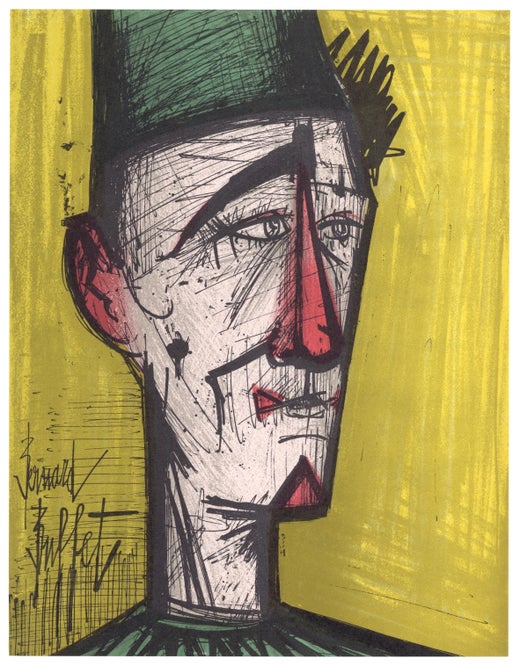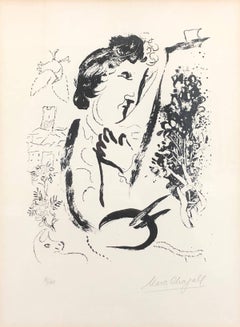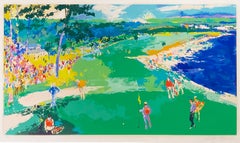Want more images or videos?
Request additional images or videos from the seller
1 of 7
Bernard BuffetPortrait of a Clown (Un Clown)1968
1968
Price:$3,750
$4,500List Price
About the Item
- Creator:Bernard Buffet (1928 - 1999, French)
- Creation Year:1968
- Dimensions:Height: 34 in (86.36 cm)Width: 25 in (63.5 cm)Depth: 1 in (2.54 cm)
- Medium:
- Movement & Style:
- Period:
- Condition:
- Gallery Location:Missouri, MO
- Reference Number:1stDibs: LU74734511031
Bernard Buffet
Bernard Buffet was born on July 10, 1928, in Paris. He was a French painter of Expressionism and a member of the anti-abstract art group L'homme Témoin. He studied art at the École Nationale supérieure des Beaux-Arts and worked in the studio of the painter Eugène Narbonne. Buffet died on October 4, 1999, in Tourtour, France.
Find a collection of original Bernard Buffet prints and other art on 1stDibs.
About the Seller
5.0
Vetted Professional Seller
Every seller passes strict standards for authenticity and reliability
Established in 1970
1stDibs seller since 2017
155 sales on 1stDibs
Typical response time: Several days
Authenticity Guarantee
In the unlikely event there’s an issue with an item’s authenticity, contact us within 1 year for a full refund. DetailsMoney-Back Guarantee
If your item is not as described, is damaged in transit, or does not arrive, contact us within 7 days for a full refund. Details24-Hour Cancellation
You have a 24-hour grace period in which to reconsider your purchase, with no questions asked.Vetted Professional Sellers
Our world-class sellers must adhere to strict standards for service and quality, maintaining the integrity of our listings.Price-Match Guarantee
If you find that a seller listed the same item for a lower price elsewhere, we’ll match it.Trusted Global Delivery
Our best-in-class carrier network provides specialized shipping options worldwide, including custom delivery.You May Also Like
"Blava taula Mexicana" (Blue Mexican Table)
By Alvar Sunol Munoz-Ramos
Located in Atlanta, GA
The lithograph, "Blava taula Mexicana" pays homage to the beautiful country of Mexico which Alvar lived for a time in his life. The subject is a poetic mixture of elements drawn from...
Category
Early 2000s Modern Prints and Multiples
Materials
Watercolor, Archival Paper, Lithograph
Two Faces, Modern Self-Portrait Lithograph of the Artist Aging in Pink & Green
By Dennis John Ashbaugh
Located in Soquel, CA
Limited edition hand signed lithograph featuring two consecutive modern portraits of faces with varying degrees of abstraction, in pink and green, by Dennis john Ashbaugh (American, b. 1946). Numbered "7/7" in the lower-left corner. Signed "Dennis John Ashbaugh" in the lower right corner. Presented in a new tan mat with foam core backing. Unframe. Image size: 4"H x 6.75"W. Some toning yellowing at mat opening.
Dennis John Ashbaugh (American, b. 1946) was born in Red Oak, Iowa, and attended California State University at Fullerton, receiving his MA in 1969. Ashbaugh has spent most of his career in New York City.
In 1992, he collaborated with William Gibson, a fiction writer, and with publisher Kevin Begos on a book, Agrippa, meaning 'book of the dead'. Exhibition venues include the Metropolitan Museum of Art in New York City, the P.S.1 Contemporary Art Center, the Seattle Art Museum, and the Whitney Museum of American ArtPublic collections holding his work include the Hirshhorn Museum, the Museum of Fine Arts, Houston, the Los Angeles County Museum of Art, and the New York Metropolitan. He received a Guggenheim Fellowship.
Ashbaugh lives in a trim frame house in Flamingo Park...
Category
1970s Modern Figurative Prints
Materials
Paper, Ink, Lithograph
$700 Sale Price
20% Off
H 8 in W 10 in D 0.25 in
"Nuit d'été (Summer's Night)" Lithograph, Colors, Linear Figures on Black Ground
By Marc Chagall
Located in Detroit, MI
SALE ONE WEEK ONLY
Marc Chagall is clearly a Modernist. Though titled "Summer Night" it could just as easily be identified as a scene from Shakespeare...
Category
Late 20th Century Modern Figurative Prints
Materials
Rag Paper, Lithograph
$12,000
H 35.75 in W 28.25 in
Social democracy. 1932, paper, lithography, 97.5x62.5 cm
Located in Riga, LV
Romans Suta
Born on April 28, 1896 in the vicinity of Cesis (Latvia), died on July 14, 1944 in Tbilisi (Georgia), rehabilitated posthumously.
Painter, graphic artist, decorative and stage designer, art critic and theoretician. Studied at the J. Madernieks' Art Studio (1913), Riga City Art School (1913-1915), and Penza Art School (1915 -1917). A prominent figure and active protagonist of modernist trends in Latvian art. Travels to Berlin and Paris, where he made the acquaintance of A. Ozanfant, Le Corbusier, and others. The influences of Cubism and Constructivism.
A member of the Riga Artists' Group (1920-1924) and the Riga Graphic Artists' Society. Painter of still lifes and figural compositions. After the first experiments in Modernism, he turned to a more realistic manner of representation. The initiator and developer of a national constructive style, especially in interior design; the founder of Baltars creative workshop for porcelain painting (1924-1928); a designer and painter at Kuznetsov...
Category
1930s Modern Figurative Prints
Materials
Paper, Lithograph
$2,948
Free Shipping
H 38.39 in W 24.61 in
“Lithograph 3”
By Marc Chagall
Located in Southampton, NY
Original colored lithograph, hand signed by the artist Narc Chagall lower right middle. Sight size is 13.75 by 10 inches. This was the cover for Lithograph 3 published by Mourlot in...
Category
1970s Modern Figurative Prints
Materials
Archival Paper, Lithograph
“When I Laid the Earth’s Foundations”
By Benton Murdoch Spruance
Located in Southampton, NY
Strong and vibrant color lithograph by the American artist, Benton Murdoch Spruance. Edition of 30 penciled left bottom margin. Titled in pencil middle margin and signed in pencil lo...
Category
1950s Modern Figurative Prints
Materials
Archival Paper, Lithograph
$895 Sale Price
29% Off
H 18.25 in W 11.75 in D 0.25 in
“Judith”
By Benton Murdoch Spruance
Located in Southampton, NY
Strong and vibrant color lithograph by the American artist, Benton Murdoch Spruance. Edition size in pencil lower left margin 7/40. Titled in pencil middle margin and signed in penc...
Category
1950s Modern Figurative Prints
Materials
Archival Paper, Lithograph
“Salome and John”
By Benton Murdoch Spruance
Located in Southampton, NY
Strong and vibrant color lithograph by the American artist Benton Murdoch Spruance. Edition size in pencil lower left margin Titled in pencil middle margin and signed in pencil lower...
Category
1950s Modern Figurative Prints
Materials
Archival Paper, Lithograph
Joyfulness. 2006. Paper, lithography, 72x54.5 cm
Located in Riga, LV
Joyfulness. 2006. Paper, lithography, 72x54.5 cm
Flamenco dancer in black and white colors
Category
Early 2000s Modern Figurative Prints
Materials
Paper, Lithograph
$404 Sale Price
20% Off
H 28.35 in W 21.46 in D 0.04 in
Caught in hand. Dancer. 2006. Paper, lithography, 72x54.5 cm
Located in Riga, LV
Caught in hand. 2006. Paper, lithography, 72x54.5 cm
Flamenco dancer in black and white colors
Category
Early 2000s Modern Figurative Prints
Materials
Paper, Lithograph
$404 Sale Price
20% Off
H 28.35 in W 21.46 in D 0.04 in
More From This Seller
View AllCuster's Last Fight
By Fritz Scholder
Located in Missouri, MO
Fritz Scholder (1937-2005)
"Custer's Last Fight"
Lithograph
Ed. 54/75
Signed and Numbered
Site Size: approx 22 x 30 inches
Framed Size: approx. 35 x 41.5 inches
Born in Breckenridge, Minnesota, Fritz Scholder became a prominent Indian portrait, figure, and genre painter in Arizona. His father was part Indian, and Fritz Scholder chose to focus his art work on this part of his lineage and to express both an appreciation and disdain for Indian customs, traditions, and daily existence.
He studied at the University of Kansas, Wisconsin State University, and with Wayne Thiebaud at Sacramento College in California. He earned an Master of Fine Arts Degree from the University of Arizona. A long-time resident of Scottsdale, Arizona, he has filled a number of artist-in-residence positions including Dartmouth College and the Oklahoma Summer Arts Institute.
In his work, he frequently showed the harsh, realistic side of Indians' lives and deaths including the affects of alcohol and other dissipations, but some of his depictions are humorous such as Indians on horseback carrying umbrellas. His brush-work is generally swift, and the tone often sombre and surreal. A major influence on his work was the contemporary British artist, Francis Bacon, from whom Scholder adapted ironic distortions into his canvases.
In Scottsdale, he lived in an adobe-walled oasis of palm trees and oleander, amid skulls and skeletons. In the garden, several of Mr. Scholder's sculptures feature skull-like heads. In the library, an 18th-century skull engraved with witchcraft symbols shared shelf space with books printed before 1500. And the porch had been converted into a skull room, complete with Mexican Day of the Dead...
Category
1970s American Modern Figurative Prints
Materials
Paper, Lithograph
Price Upon Request
Le Christ a l'Horloge, Paris (Christ in the Clock)
By Marc Chagall
Located in Missouri, MO
Marc Chagall
"Le Christ a l'Horloge, Paris" (Christ in the Clock) 1957 (M. 196)
Color Lithograph on Arches Wove Paper
Signed in Pencil "Marc Chagall" Lower Right
Initialed "H.C." (Hors Commerce) Lower Left, aside from numbered edition of 90
*Floated in Gold Frame with Linen Matting, UV Plexiglass
Sheet Size: 18 3/4 x 14 3/4 inches (47.5 cm x 38 cm)
Image Size: 9 3/4 x 8 1/2 inches
Framed Size: 28.5 x 24.25 inches
Marc Chagall was a man of keen intelligence, a shrewd observer of the contemporary scene, with a great sympathy for human suffering. He was born on July 7, 1887 in Vitebsk, Russia; his original name was Moishe Shagal (Segal), but when he became a foremost member of the Ecole de Paris, he adopted French citizenship and the French spelling of his name. Vitebsk was a good-sized Russian town of over 60,000, not a shtetl. His father supported a wife and eight children as a worker in a herring-pickling plant.
Sheltered by the Jewish commandment against graven images, the young Chagall never saw so much as a drawing until, one day, he watched a schoolmate copying a magazine illustration. He was ridiculed for his astonishment, but he began copying and improvising from magazines. Both Chagall's parents reluctantly agreed to let him study with Yehuda Pen, a Jewish artist in Vitebsk. Later, in 1906, they allowed their son to study in St. Petersburg, where he was exposed to Russian Iconography and folk art. At that time, Jews could leave the Pale only for business and employment and were required to carry a permit. Chagall, who was in St. Petersburg without a permit, was imprisoned briefly.
His first wife, Bella Rosenfeld, was a product of a rich cultivated and intellectual group of Jews in Vitebsk. Chagall was made commissar for the arts for the area, charged with directing its cultural life and establishing an art school. Russian folklore, peasant life and landscapes persisted in his work all his life. In 1910 a rich patron, a lawyer named Vinaver, staked him to a crucial trip to Paris, where young artists were revolutionizing art. He also sent him a handsome allowance of 125 francs (in those days about $24) each month. Chagall rejected cubism, fauvism and futurism, but remained in Paris. He found a studio near Montparnasse in a famous twelve-sided wooden structure divided into wedge-shaped rooms. Chaim Soutine, a fellow Russian Jew, and Modigliani lived on the same floor. To Chagall's astonishment, he found himself heralded as one of the fathers of surrealism. In 1923, a delegation of Max Ernst, Paul Eluard and Gala (later Salvador Dali's wife) actually knelt before Chagall, begging him to join their ranks. He refused.
To understand Chagall's work, it is necessary to know that he was born a Hasidic Jew, heir to mysticism and a world of the spirit, steeped in Jewish lore and reared in the Yiddish language. The Hasidim had a special feeling for animals, which they tried not to overburden. In the mysterious world of Kabbala and fantastic ancient legends of Chagall's youth, the imaginary was as important as the real. His extraordinary use of color also grew out of his dream world; he did not use color realistically, but for emotional effect and to serve the needs of his design. Most of his favorite themes, though superficially light and trivial, mask dark and somber thoughts. The circus he views as a mirror of life; the crucifixion as a tragic theme, used as a parallel to the historic Jewish condition, but he is perhaps best known for the rapturous lovers he painted all his life. His love of music is a theme that runs through his paintings.
After a brief period in Berlin, Chagall, Bella and their young daughter, Ida, moved to Paris and in 1937 they assumed French citizenship. When France fell, Chagall accepted an invitation from the Museum of Modern Art to immigrate to the United States. He was arrested and imprisoned in Marseilles for a short time, but was still able to immigrate with his family. The Nazi onslaught caught Chagall in Vichy, France, preoccupied with his work. He was loath to leave; his friend Varian Fry rescued him from a police roundup of Jews in Marseille, and packed him, his family and 3500 lbs. of his art works on board a transatlantic ship. The day before he arrived in New York City, June 23, 1941, the Nazis attacked Russia. The United States provided a wartime haven and a climate of liberty for Chagall. In America he spent the war years designing large backdrops for the Ballet.
Bella died suddenly in the United States of a viral infection in September 1944 while summering in upstate New York. He rushed her to a hospital in the Adirondacks, where, hampered by his fragmentary English, they were turned away with the excuse that the hour was too late. The next day she died.
He waited for three years after the war before returning to France. With him went a slender married English girl, Virginia Haggard MacNeil; Chagall fell in love with her and they had a son, David. After seven years she ran off with an indigent photographer. It was an immense blow to Chagall's ego, but soon after, he met Valentine Brodsky, a Russian divorcee designing millinery in London (he called her Fava). She cared for him during the days of his immense fame and glory. They returned to France, to a home and studio in rustic Vence. Chagall loved the country and every day walked through the orchards, terraces, etc. before he went to work.
Chagall died on March 28, 1985 in the south of France. His heirs negotiated an arrangement with the French state allowing them to pay most of their inheritance taxes in works of art. The heirs owed about $30 million to the French government; roughly $23 million of that amount was deemed payable in artworks. Chagall's daughter, Ida and his widow approved the arrangement.
Written and submitted by Jean Ershler Schatz, artist and researcher from Laguna Woods, California.
Sources:
Hannah Grad Goodman in Homage to Chagall in Hadassah Magazine, June 1985
Jack Kroll in Newsweek, April 8, 1985
Andrea Jolles in National Jewish Monthly Magazine, May 1985
Michael Gibson...
Category
1950s Modern Figurative Prints
Materials
Lithograph
Devant le Tableau (Signed and Numbered)
By Marc Chagall
Located in Missouri, MO
Lithograph on Arches Paper
Pencil Signed Lower Right, "Marc Chagall"
Numbered Lower Left Ed. 9/40, one of 40 impressions reserved for the artist aside from the standard signed editio...
Category
1960s Modern Figurative Prints
Materials
Lithograph
Price Upon Request
The 18th at Pebble Beach
By LeRoy Neiman
Located in Missouri, MO
The 18th at Pebble Beach
Leroy Neiman (American, 1921-2012)
Signed in pencil lower right
Edition 176/400 lower left
26 x 43 inches
37.25 x 54.5 inches with frame
Known for his bright, colorful paintings and screen prints of famous sports stars...
Category
20th Century American Modern Landscape Prints
Materials
Color, Lithograph
L'Offrande (Signed and Numbered)
By Marc Chagall
Located in Missouri, MO
Lithograph on Arches Paper
Pencil Signed Lower Right, "Marc Chagall"
Numbered Lower Left Ed. 51/100
Published by CH. SORLIER
SIte Size: 19 x 12.5
Framed Size: approx 27.5 x 22.5
Category
1960s Modern Figurative Prints
Materials
Lithograph
Price Upon Request
Cove at Vintage
By LeRoy Neiman
Located in Missouri, MO
Cove at Vintage
Leroy Neiman (American, 1921-2012)
Signed in pencil lower right
Edition 237/375 lower left
34 x 36.5 inches
43 x 45.5 inches with frame
Known for his bright, colorful paintings and screen prints of famous sports stars...
Category
20th Century American Modern Landscape Prints
Materials
Color, Lithograph



